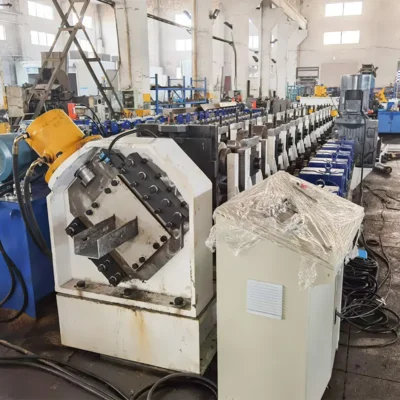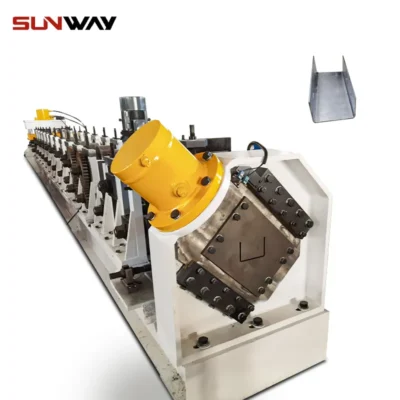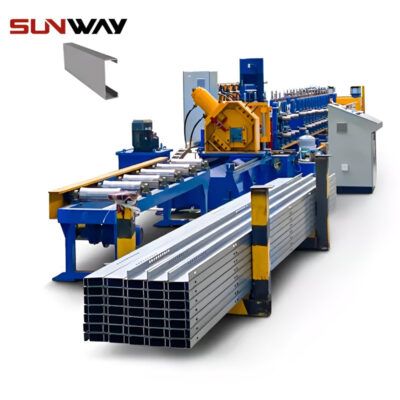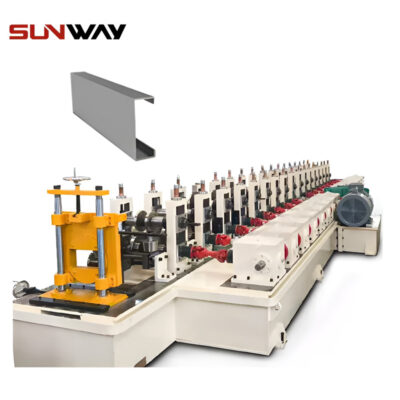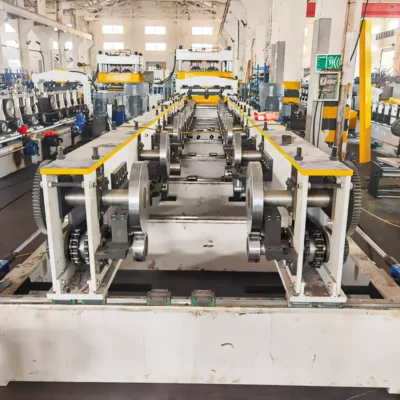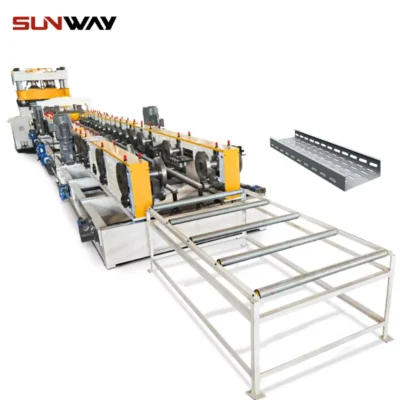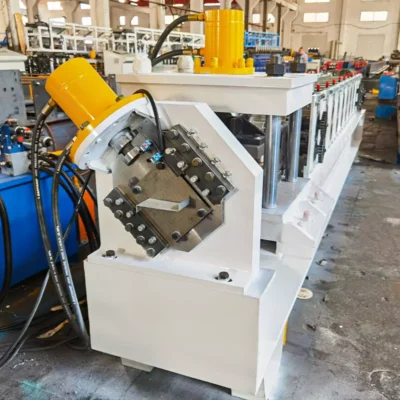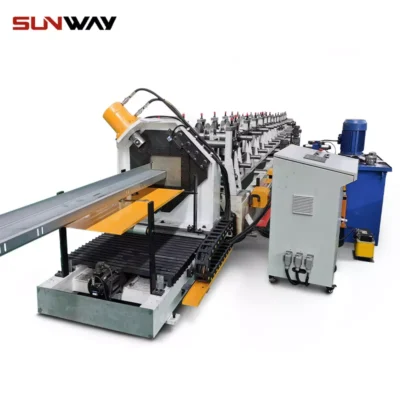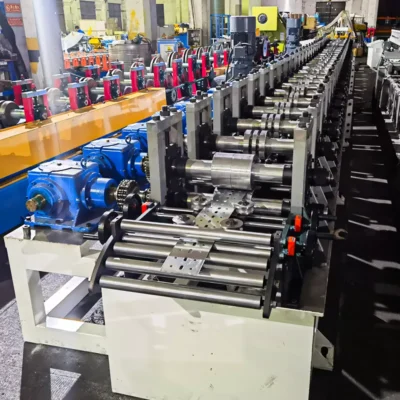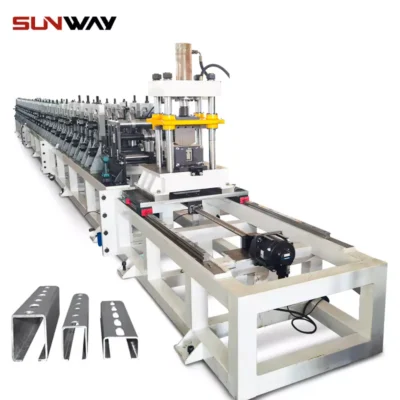In the realm of modern urban planning and civil engineering, pedestrian bridges play an essential role. These structures ensure safe passage for people over busy roads, highways, railways, and rivers, improving traffic flow and enhancing safety. But constructing these bridges requires durable, lightweight, and precisely engineered components to ensure stability, longevity, and ease of assembly. Enter the Pedestrian Bridge Roll Forming Machines—a transformative solution for producing high-quality structural profiles at scale.
With urbanization accelerating across the globe, the demand for pedestrian bridges has never been higher. Governments and private contractors are seeking cost-effective and efficient ways to design pedestrian bridges that meet stringent safety and aesthetic standards. Pedestrian Bridge Roll Forming Machines are a critical enabler in this process, allowing manufacturers to produce the steel and aluminum profiles needed for bridge frames, decks, and railings with unparalleled precision.
In this comprehensive guide, we’ll delve into the features, applications, market trends, pricing, and benefits of these machines. We’ll also highlight why Wuxi Sunway Machinery is a trusted name in delivering innovative roll-forming solutions for infrastructure projects.
What is a Pedestrian Bridge Roll Forming Machine?
A Pedestrian Bridge Roll Forming Machine is a specialized industrial system designed to manufacture structural profiles used in the construction of pedestrian bridges. These profiles, often made from galvanized steel, stainless steel, or aluminum, form the framework, decking, and railings of pedestrian bridges, ensuring strength and durability.
The machine works by feeding raw metal coils into a series of rollers that shape the material into specific profiles. These profiles are then assembled to form the structural components of the bridge. By automating the production process, roll-forming machines ensure consistency, precision, and efficiency, reducing costs and production timelines.
Applications of Pedestrian Bridge Roll Forming Machines
Pedestrian bridge components produced by roll-forming machines are used in various infrastructure projects, ranging from urban developments to rural connectivity initiatives. Here’s how these machines contribute to bridge construction:
1. Urban Pedestrian Bridges
- Use Case: Steel profiles for overpasses in cities, connecting sidewalks or public spaces.
- Why It Matters: Provides safe passage for pedestrians over busy traffic intersections.
2. Highway Overpasses
- Use Case: Lightweight aluminum profiles for pedestrian bridges spanning highways.
- Why It’s Crucial: Ensures durability while minimizing the weight for easier construction.
3. Railway Crossings
- Use Case: Galvanized steel profiles for bridges over railway tracks.
- Why It’s Important: Offers corrosion resistance to withstand weather and environmental conditions.
4. Pedestrian-Only Footbridges
- Use Case: Profiles for footbridges across rivers, parks, or scenic locations.
- Why It’s Relevant: Enhances the aesthetic appeal while maintaining structural integrity.
5. Industrial and Commercial Complexes
- Use Case: Railings and walkways for pedestrian bridges in factories or large campuses.
- Why It’s Critical: Provides safe and efficient movement within industrial or commercial spaces.
6. Emergency and Temporary Bridges
- Use Case: Modular profiles for temporary pedestrian bridges used during emergencies or construction projects.
- Why It’s Exciting: Roll-formed profiles enable rapid assembly and disassembly for temporary installations.
Key Features of Wuxi Sunway Pedestrian Bridge Roll Forming Machines
Wuxi Sunway Machinery is a global leader in roll-forming technology, offering machines tailored to the unique demands of infrastructure projects. Here are the standout features of their Pedestrian Bridge Roll Forming Machines:
1. High-Strength Material Processing
- Supported Materials:
- Galvanized steel
- Stainless steel
- Aluminum alloys
- Why It Matters: Ensures the production of profiles that meet the strength and durability requirements of pedestrian bridges.
2. Multi-Profile Compatibility
- What It Supports: Machines can produce various profiles, including channels, beams, and railings.
- Why It’s Beneficial: Allows manufacturers to cater to diverse bridge designs and specifications.
3. Precision Rollers
- What It Ensures: Rollers engineered for tight tolerances and consistent shaping.
- Why It’s Crucial: Guarantees uniformity in every profile, ensuring compatibility during assembly.
4. Integrated Cutting and Punching
- What It Offers: Built-in systems for cutting profiles to length and creating holes or slots.
- Why It’s Revolutionary:
- Reduces the need for additional processing.
- Speeds up production timelines.
- Ensures accurate alignment for easy installation.
5. Lightweight Profile Production
- What It Achieves: Optimized for producing lightweight profiles without compromising strength.
- Why It’s Essential: Supports the construction of bridges that require minimal load on foundations.
6. IoT and Automation Integration
- What It Provides: Real-time monitoring, data collection, and automated adjustments through IoT-enabled sensors.
- Why It’s Critical:
- Enhances production efficiency and minimizes errors.
- Enables predictive maintenance to reduce downtime.
- Supports smart manufacturing initiatives.
7. High-Speed Production
- Performance: Capable of producing up to 30 meters of profiles per minute, depending on the material and design.
- Why It’s Relevant: Meets the high-volume demands of large-scale infrastructure projects.
8. Energy-Efficient Design
- What It Includes: Energy-saving motors and optimized power consumption systems.
- Why It Matters: Reduces operational costs and aligns with sustainability goals in infrastructure development.
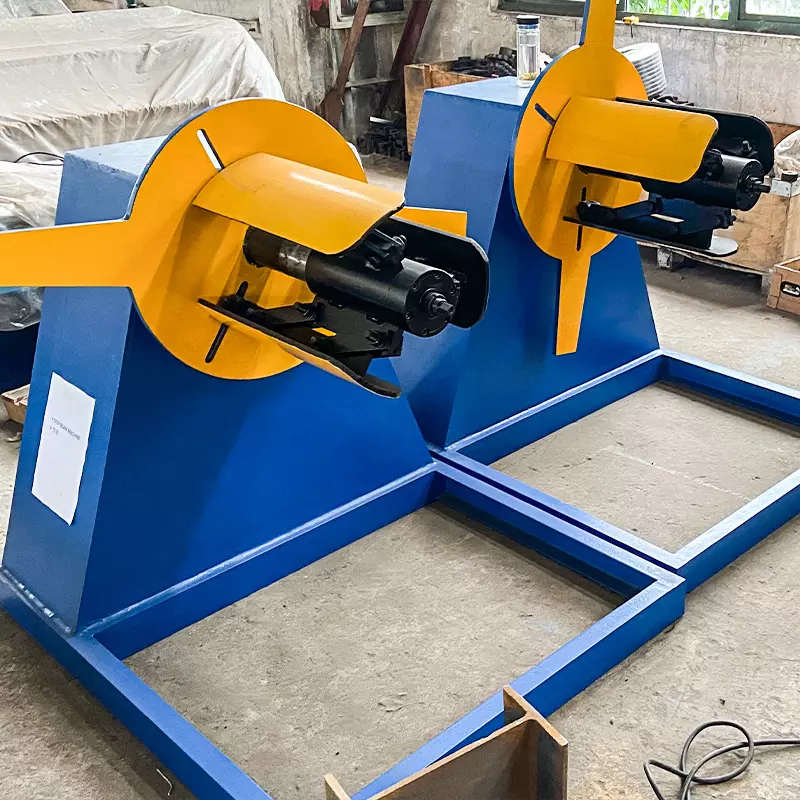
Production Workflow of a Pedestrian Bridge Roll Forming Machine
The production process for pedestrian bridge components is designed to be efficient, precise, and scalable. Here’s an overview of the workflow:
1. Material Loading
- Raw metal coils are loaded onto the machine’s decoiler, which feeds the material into the rollers.
2. Leveling
- A leveling system ensures the material is flat and free of defects before entering the roll-forming section.
3. Roll Forming
- The material passes through a series of rollers that shape it into the desired profile incrementally.
4. Punching and Cutting
- Integrated systems create holes, slots, or embossing patterns and cut the profiles to the required lengths.
5. Quality Inspection
- Each profile is inspected for dimensional accuracy and surface finish to ensure compliance with design specifications.
6. Stacking and Packaging
- Finished profiles are automatically stacked and prepared for transportation to the construction site.
Pricing of Pedestrian Bridge Roll Forming Machines
The cost of a Pedestrian Bridge Roll Forming Machine depends on its features, production capacity, and customization options. Below is a general pricing guide for 2025:
| Machine Type | Capabilities | Price Range (USD) |
|---|---|---|
| Standard Machines | Basic profile production | $180,000–$250,000 |
| Advanced Machines | High-speed and multi-profile output | $250,000–$400,000 |
| Customizable Machines | Including punching, IoT, and automation | $400,000–$600,000 |
For specific pricing and financing options, contact Wuxi Sunway Machinery.
Market Trends and Growth Opportunities in 2025
The demand for pedestrian bridges is growing globally, driven by urbanization, sustainability goals, and infrastructure development initiatives. Here’s what’s shaping the market for Pedestrian Bridge Roll Forming Machines:
1. Urbanization and Smart Cities
- The Trend: Cities are expanding vertically and horizontally, increasing the need for pedestrian bridges to enhance connectivity.
- Impact on Machines:
- Demand for high-volume production of bridge components.
- Roll-forming machines must cater to diverse design requirements.
2. Sustainability Goals
- The Goal: Governments are prioritizing eco-friendly infrastructure projects to reduce carbon footprints.
- How Machines Help:
- Produce lightweight, recyclable profiles that align with green building standards.
- Support the use of energy-efficient materials like aluminum.
3. Modular Bridge Construction
- The Opportunity: Modular pedestrian bridges are gaining popularity for their speed of installation and cost-effectiveness.
- Why It Matters:
- Roll-forming machines enable the production of modular profiles for quick assembly and disassembly.
- Ideal for temporary or rapidly deployable solutions.
4. Infrastructure Investments in Emerging Markets
- The Shift: Developing countries are investing heavily in infrastructure to improve connectivity and quality of life.
- Why It’s Relevant:
- Localized production of bridge components reduces costs and transportation emissions.
- Roll-forming machines support regional infrastructure initiatives.
FAQs About Pedestrian Bridge Roll Forming Machines
| Question | Answer |
|---|---|
| Can these machines produce custom profiles? | Yes, modular tooling systems allow for the production of custom profiles for unique bridge designs. |
| What materials can the machine process? | Supported materials include galvanized steel, stainless steel, and aluminum alloys. |
| Does Wuxi Sunway offer training and support? | Absolutely! Comprehensive training and after-sales support are provided with every machine. |
| What is the average production speed? | Machines can produce up to 30 meters of profiles per minute, depending on the material. |
| Are financing options available? | Yes, Wuxi Sunway offers flexible financing solutions for qualified buyers. |
| What industries use this machine? | Industries include infrastructure, construction, and civil engineering. |
Efficiency Benefits of Pedestrian Bridge Roll Forming Machines
Efficiency is the hallmark of any successful manufacturing process, and Pedestrian Bridge Roll Forming Machines are designed to deliver maximum output with minimal input. Here’s how these machines enhance efficiency:
1. Faster Production Speeds
- How It Works: Advanced roller systems and high-speed servo motors streamline the forming process.
- Why It’s Important:
- Produces up to 30 meters of structural profiles per minute, meeting tight project deadlines.
- Enables manufacturers to scale production for large infrastructure projects.
2. Seamless Integration of Processes
- What It Includes: Punching, cutting, and embossing are integrated into the roll-forming process.
- Advantages:
- Eliminates the need for separate machines or secondary operations.
- Reduces labor costs and production timelines.
- Ensures perfect alignment of holes and slots for easier assembly.
3. Minimal Material Waste
- The Innovation: Precision rollers and cutting systems shape metal profiles with minimal scrap.
- Why It Matters:
- Conserves raw materials, reducing costs for manufacturers.
- Supports sustainable manufacturing practices by avoiding excess waste.
4. Automation and IoT Integration
- What It Enables: IoT sensors monitor machine performance and make real-time adjustments.
- Efficiency Gains:
- Reduces downtime due to predictive maintenance.
- Optimizes production settings for each batch, ensuring consistency.
- Allows operators to oversee multiple machines simultaneously.
5. Versatility in Design
- How It Helps: Modular tooling systems allow manufacturers to switch between different profile designs without extensive retooling.
- Why It’s Beneficial:
- Supports diverse project needs, from urban overpasses to rural footbridges.
- Adapts to custom designs for unique architectural requirements.
Environmental Impacts of Pedestrian Bridge Roll Forming Machines
As the world moves toward greener infrastructure, the role of Pedestrian Bridge Roll Forming Machines in sustainable manufacturing cannot be overlooked. Here’s how these machines contribute to environmental stewardship:
1. Use of Sustainable Materials
- What It Supports: Machines process recyclable materials like aluminum and steel.
- Environmental Benefit:
- Promotes a circular economy by enabling the reuse of materials.
- Reduces the demand for virgin resources, lowering environmental impact.
2. Energy-Efficient Operations
- How It Works: Energy-saving motors and optimized workflows minimize power consumption.
- Why It Matters:
- Reduces electricity usage, lowering the carbon footprint of manufacturing.
- Aligns with global sustainability goals for infrastructure projects.
3. Reduced Transportation Emissions
- What It Enables: Localized production of bridge components reduces the need for long-distance transportation.
- Impact:
- Lowers greenhouse gas emissions associated with shipping.
- Enhances supply chain efficiency for regional projects.
4. Minimal Waste Generation
- The Advantage: High-precision rollers and cutting systems ensure maximum material utilization.
- Why It’s Important:
- Reduces landfill waste.
- Lowers costs for disposing of scrap materials.
5. Durability of Finished Components
- How It Helps: Roll-formed profiles are engineered for longevity, reducing the need for frequent repairs or replacements.
- Environmental Benefit:
- Extends the lifespan of pedestrian bridges, lowering resource consumption over time.
- Enhances the sustainability of public infrastructure investments.
Real-World Use Cases of Pedestrian Bridge Roll Forming Machines
The versatility of Pedestrian Bridge Roll Forming Machines makes them invaluable for a wide range of infrastructure projects. Here are some real-world applications where these machines shine:
1. Urban Overpasses in Mega-Cities
- Scenario: A bustling metro area requires pedestrian bridges to safely connect shopping malls, office complexes, and public transit hubs.
- Machine Contribution:
- Produces lightweight, high-strength profiles for overpasses with minimal visual obstruction.
- Supports modular designs for quick assembly in high-traffic areas.
2. Sustainable Bridges in National Parks
- Scenario: A national park needs eco-friendly pedestrian bridges to enhance visitor access without disturbing the natural environment.
- Machine Contribution:
- Creates corrosion-resistant aluminum profiles for bridges exposed to weather and moisture.
- Enables the use of recyclable materials for environmentally conscious construction.
3. Emergency Relief Bridges
- Scenario: A natural disaster damages critical infrastructure, requiring temporary pedestrian bridges for humanitarian aid.
- Machine Contribution:
- Produces modular profiles that can be rapidly assembled and disassembled.
- Supports lightweight designs for easy transportation to remote locations.
4. Railway Overpasses in Developing Regions
- Scenario: A growing city in a developing country needs safe pedestrian crossings over railway tracks.
- Machine Contribution:
- Manufactures galvanized steel profiles that resist corrosion in humid environments.
- Allows for cost-effective production to meet budget constraints.
5. Iconic Architectural Footbridges
- Scenario: A city commissions a landmark pedestrian bridge as a centerpiece for its riverside development.
- Machine Contribution:
- Produces custom-designed profiles with complex curves and aesthetic features.
- Ensures structural integrity while achieving a visually striking design.
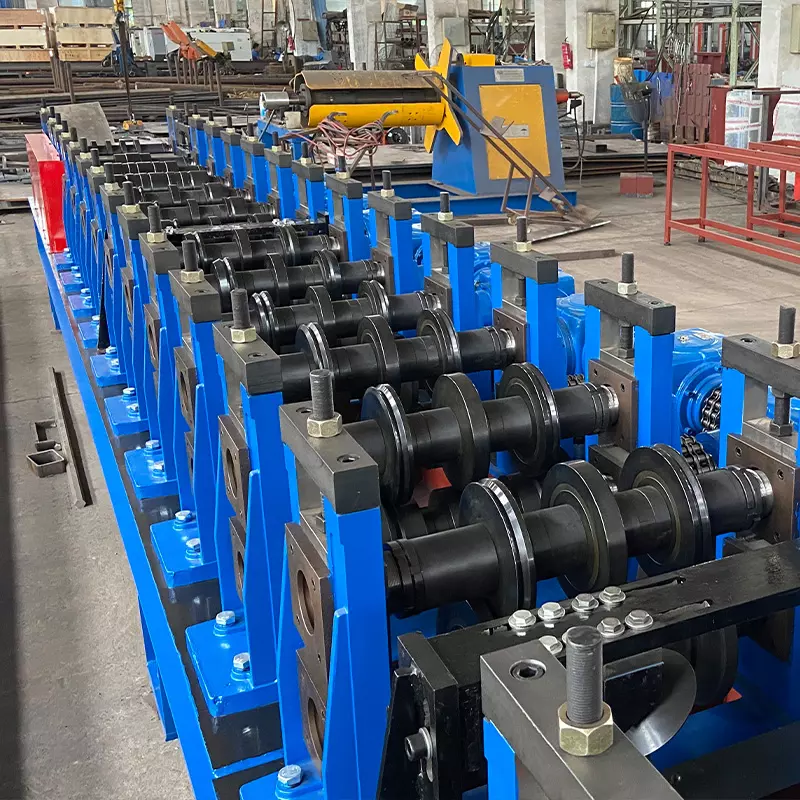
Advanced Technologies in Pedestrian Bridge Roll Forming Machines
Modern Pedestrian Bridge Roll Forming Machines are equipped with advanced technologies that set them apart from traditional manufacturing methods. Here’s a look at the innovations driving their success:
1. AI-Powered Quality Control
- How It Works: Artificial Intelligence (AI) continuously monitors production for defects or deviations from specifications.
- Benefits:
- Ensures every profile meets exacting standards for safety and performance.
- Reduces waste by catching issues early in the process.
2. Laser Cutting Integration
- What It Adds: High-precision laser systems cut profiles to exact lengths and create intricate patterns.
- Why It’s Revolutionary:
- Enables complex designs for architectural bridges.
- Provides clean, burr-free edges that require no secondary finishing.
3. Modular Tooling Systems
- What It Enables: Quick reconfiguration of rollers and dies for different profile designs.
- Why It’s Essential:
- Supports diverse project requirements without extensive downtime.
- Enhances machine versatility for manufacturers serving multiple clients.
4. Cloud-Based Monitoring
- What It Offers: IoT-enabled machines upload performance data to a cloud platform for remote access and analysis.
- Advantages:
- Allows manufacturers to monitor production from anywhere.
- Facilitates predictive maintenance to avoid costly breakdowns.
5. Advanced Material Handling
- What It Includes: Automated feeding systems and leveling units ensure a seamless flow of raw materials.
- Why It’s Important:
- Speeds up production cycles by eliminating manual intervention.
- Ensures consistent quality across all profiles.
FAQs About Pedestrian Bridge Roll Forming Machines
| Question | Answer |
|---|---|
| Can these machines handle custom designs? | Yes, they can produce profiles with unique shapes and features tailored to specific bridge designs. |
| What is the average lead time for production? | Machines can produce up to 30 meters of profiles per minute, enabling quick project turnarounds. |
| Are these machines suitable for outdoor profiles? | Absolutely! They support materials like galvanized steel and aluminum, which are ideal for outdoor use. |
| Does Wuxi Sunway offer installation support? | Yes, they provide full installation, training, and after-sales support for every machine. |
| What industries benefit from these machines? | Key sectors include construction, civil engineering, and public infrastructure development. |
Why Wuxi Sunway Machinery is the Best Choice
When it comes to Pedestrian Bridge Roll Forming Machines, Wuxi Sunway Machinery has established itself as a global leader. Here’s why:
- Unmatched Expertise: Decades of experience in roll-forming solutions for infrastructure and construction.
- Custom Solutions: Tailored machines designed to meet the specific needs of pedestrian bridge manufacturers.
- Global Network: Trusted by clients across Asia, Europe, the Americas, and beyond.
- Sustainability Focus: Machines designed to support eco-friendly manufacturing practices.
- Cutting-Edge Technology: Features like AI integration, IoT connectivity, and modular tooling.
- Comprehensive Support: From installation to troubleshooting, Sunway ensures your operations run smoothly.
Conclusion: Building Bridges for a Better Tomorrow
The Pedestrian Bridge Roll Forming Machine is more than just a manufacturing tool—it’s a cornerstone of modern infrastructure development. By enabling the production of high-quality, precision-engineered components, these machines empower cities and communities to build bridges that enhance safety, connectivity, and sustainability.
Looking to elevate your manufacturing capabilities and contribute to the next generation of infrastructure? Contact Wuxi Sunway Machinery today to explore their innovative roll-forming solutions. Together, let’s bridge the gap to a smarter, safer, and more connected world—one profile at a time!

